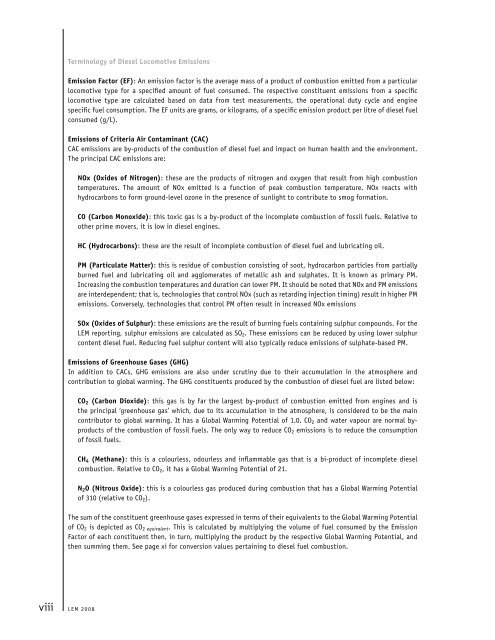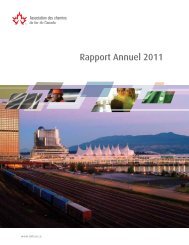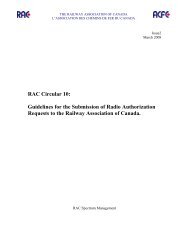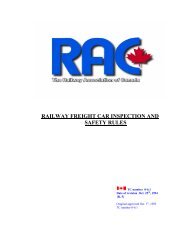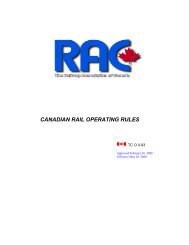Locomotive Emissions Monitoring Program - Railway Association of ...
Locomotive Emissions Monitoring Program - Railway Association of ...
Locomotive Emissions Monitoring Program - Railway Association of ...
Create successful ePaper yourself
Turn your PDF publications into a flip-book with our unique Google optimized e-Paper software.
Terminology <strong>of</strong> Diesel <strong>Locomotive</strong> <strong>Emissions</strong><br />
Emission Factor (EF): An emission factor is the average mass <strong>of</strong> a product <strong>of</strong> combustion emitted from a particular<br />
locomotive type for a specified amount <strong>of</strong> fuel consumed. The respective constituent emissions from a specific<br />
locomotive type are calculated based on data from test measurements, the operational duty cycle and engine<br />
specific fuel consumption. The EF units are grams, or kilograms, <strong>of</strong> a specific emission product per litre <strong>of</strong> diesel fuel<br />
consumed (g/L).<br />
<strong>Emissions</strong> <strong>of</strong> Criteria Air Contaminant (CAC)<br />
CAC emissions are by-products <strong>of</strong> the combustion <strong>of</strong> diesel fuel and impact on human health and the environment.<br />
The principal CAC emissions are:<br />
NOx (Oxides <strong>of</strong> Nitrogen): these are the products <strong>of</strong> nitrogen and oxygen that result from high combustion<br />
temperatures. The amount <strong>of</strong> NOx emitted is a function <strong>of</strong> peak combustion temperature. NOx reacts with<br />
hydrocarbons to form ground-level ozone in the presence <strong>of</strong> sunlight to contribute to smog formation.<br />
CO (Carbon Monoxide): this toxic gas is a by-product <strong>of</strong> the incomplete combustion <strong>of</strong> fossil fuels. Relative to<br />
other prime movers, it is low in diesel engines.<br />
HC (Hydrocarbons): these are the result <strong>of</strong> incomplete combustion <strong>of</strong> diesel fuel and lubricating oil.<br />
PM (Particulate Matter): this is residue <strong>of</strong> combustion consisting <strong>of</strong> soot, hydrocarbon particles from partially<br />
burned fuel and lubricating oil and agglomerates <strong>of</strong> metallic ash and sulphates. It is known as primary PM.<br />
Increasing the combustion temperatures and duration can lower PM. It should be noted that NOx and PM emissions<br />
are interdependent; that is, technologies that control NOx (such as retarding injection timing) result in higher PM<br />
emissions. Conversely, technologies that control PM <strong>of</strong>ten result in increased NOx emissions<br />
SOx (Oxides <strong>of</strong> Sulphur): these emissions are the result <strong>of</strong> burning fuels containing sulphur compounds. For the<br />
LEM reporting, sulphur emissions are calculated as SO 2 . These emissions can be reduced by using lower sulphur<br />
content diesel fuel. Reducing fuel sulphur content will also typically reduce emissions <strong>of</strong> sulphate-based PM.<br />
<strong>Emissions</strong> <strong>of</strong> Greenhouse Gases (GHG)<br />
In addition to CACs, GHG emissions are also under scrutiny due to their accumulation in the atmosphere and<br />
contribution to global warming. The GHG constituents produced by the combustion <strong>of</strong> diesel fuel are listed below:<br />
CO 2 (Carbon Dioxide): this gas is by far the largest by-product <strong>of</strong> combustion emitted from engines and is<br />
the principal ‘greenhouse gas’ which, due to its accumulation in the atmosphere, is considered to be the main<br />
contributor to global warming. It has a Global Warming Potential <strong>of</strong> 1.0. CO 2 and water vapour are normal byproducts<br />
<strong>of</strong> the combustion <strong>of</strong> fossil fuels. The only way to reduce CO 2 emissions is to reduce the consumption<br />
<strong>of</strong> fossil fuels.<br />
CH 4 (Methane): this is a colourless, odourless and inflammable gas that is a bi-product <strong>of</strong> incomplete diesel<br />
combustion. Relative to CO 2 , it has a Global Warming Potential <strong>of</strong> 21.<br />
N 2 O (Nitrous Oxide): this is a colourless gas produced during combustion that has a Global Warming Potential<br />
<strong>of</strong> 310 (relative to CO 2 ).<br />
The sum <strong>of</strong> the constituent greenhouse gases expressed in terms <strong>of</strong> their equivalents to the Global Warming Potential<br />
<strong>of</strong> CO 2 is depicted as CO 2 equivalent . This is calculated by multiplying the volume <strong>of</strong> fuel consumed by the Emission<br />
Factor <strong>of</strong> each constituent then, in turn, multiplying the product by the respective Global Warming Potential, and<br />
then summing them. See page xi for conversion values pertaining to diesel fuel combustion.<br />
viii LEM 2008


